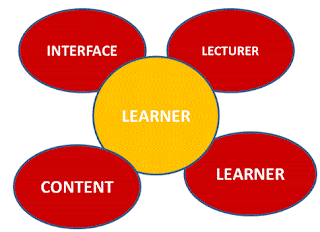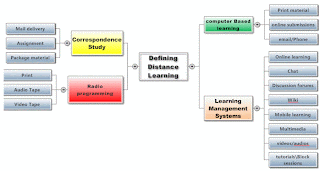My earlier definition of distance learning had
been built through my experiences of learning over a number of decades. I had
initial thought of distance learning as being for adults only, and only those who
did not have opportunities to complete their studies. In the late 1970’s my
father had studied and completed his high school through correspondence study.
With that experience in mind, I then defined distance education in terms of the
money exchange with the package of study material, and assignment submissions
through mail posting. This was in line with the view of distance learning as a
study for “adults with occupational, social, and family commitments” where
posting was used as the medium of communication with no physical contact
(Simonson, Smaldino, Albright, and Zvacek, 2012). The biggest challenge for
correspondence study was time delay in the delivery of the learning material.
As I grew up, my definition of
distance learning changed slightly. While I was at university in the late
1980’s, one of my friends had registered for a module through distance
learning. She would receive a package with audio cassette and videos. Tracey
& Richey, (2005) mention that “radio programming has been used innovatively
to either support or supplement print based materials or to carry the majority
of the course content”. My definition of distance learning changed slightly
therefore to include media which accommodated listening skills for students. The new definition brought in an element of
the face to face classes but still lacked interaction between teachers and
students and interaction amongst students. Simonson,
Smaldino, Albright, and Zvacek, (2012) points out that “it is important that
learners be able to interact with each other, with resources of instruction,
and with their teacher” (p.34). My definition of distance learning then evolved
to include learning for anyone, at any place and at any time through mail
correspondence with learning material that included cassettes and video tapes.
In the mid 2000’s, I personally
enrolled with a distance learning university. The scenario was very different from
what I had known about distance learning as the audio and video cassettes had largely
been replaced with CDs and DVDs “to provide valuable resource materials for
distance learners” (Tracey & Richey, 2005). The post medium was still in
use, mostly for the delivery of learning material but with an option of submitting
assignments online. There were also opportunities of “real-time interaction”
with the teachers, through optional tutorial classes, phone calls and emails to
supplement the learning material (Moller, et al., 2008). The definition of
distance learning changed then to include “flexible learning with increased
access and hence more openness” (Bates, 2005). The challenge still remained
that of lack of communication with other students.
Fig. 1: Learner as a central
point
Fig.2. Mind Map
The University I work for is currently
offering a number of distance learning courses, hybrid courses that complement
face to face classes with a distance learning component, and has partnerships
with other distance learning institutions (Tracey & Richey, 2005). The
institution has also invested extensively in “state of the art” infrastructure
to support distance education by hiring high profile personnel to support
technology for teaching distance learning, using and supporting the use of
learning management systems. These changes are based on emerging global trends
where various teaching and learning tools that support distance learning have
been on the rise.
In conclusion, my definition of
distance learning (See Fig. 2) regards it as a method of learning through a
variety of correspondence media (post, telephone, radio, video, computers and
internet) where students are able to study anywhere, anytime using various learning styles (reading, listening,
discussion, group work) with limited physical contact. Gunes & Altintas
(2013) argue that “the most important question on distance education is: ‘How can
we improve the learning level, by which media?’ and ‘How can we set a high
level interaction between the students and the teacher?’” (p.70). Distance
learning has evolved over a 180 years (1833-2013) through the development of
delivery media and technology (Laureate Education, Inc., 2009). While “mail
correspondence” for example, is still being used today with more options to reduce
time delays for delivery to almost zero thus improving the level of learning
through distance learning. The levels of interaction can also be set high with
the use of current trends in synchronous technology such as Skype.
Fig. 3.
Challenges of distance learning
References
Bates, A.W.
(2005). Technology, E-Learning, and
Distance Education (2nd edition). Routledge, Canada.
Gunes, A. &
Altintas, T. (2013). Evaluation of Distance Education Components of e-MBA
program – A Case Study. International
Journal on E-Learning, 12 (1), 69-80.
Laureate
Education, Inc. (Producer). (2009). Distance Learning Timeline Continuum
[Multimedia Program]. Retrieved from https://class.waldenu.edu/webapps/portal/frameset.jsp?tab_tab_group_id=_2_1&url=%2Fwebapps%2Fblackboard%2Fexecute%2Flauncher%3Ftype%3DCourse%26id%3D_3467554_1%26url%3D.
Moller, L.,
Foshay, W., & Huett, J. (2008). The evolution of distance education:
Implications for instructional design on the potential of the web (Part 1:
Training and Development Key Trends in training). TechTrends, 52(3), 70 - 76.
Morrison, G. R., Ross, S. M.,
Kalman, H. K., & Kemp, J. E. (2011). Designing
effective instruction (6th ed.). Hoboken, NJ: John Wiley & Sons.
Simonson, M., Smaldino, S.,
Albright, M., & Zvacek, S. (2012). Teaching
and learning at a distance: Foundations of distance education (5th ed.)
Boston, MA: Pearson.
Tracey, M., & Richey, R.
(2005). The evolution of distance education. Distance Learning, 2(6), 17–21. Retrieved 3 September from http://sloanconsortium.org/




You really had a journey through the definitions of distance education. But that's how it is, we experience new things, get new input and suddenly our view changes. Sometimes to leave what was and see something new, and sometimes, as for you, the perception broadened and become larger. Great to see and also for me to get the insight.
ReplyDeleteThanks Thuthu
/Millan
Thanks, Milan for reading my post.
ReplyDelete